Apple MacBook Pro 13: Can a Mac Be a Decent Windows Laptop?
by Vivek Gowri on October 14, 2010 9:00 PM ESTApple MacBook Pro 13—Core 2 Duo Performance
It’s kind of embarrassing to be reviewing a $1200 computer with a two year old processor and application performance to match. It’s not that evident in day to day use, and in most games performance is more dependant on the graphics card, but application performance benchmarks are where the Core 2 Duo really makes itself felt (and not in a good way).
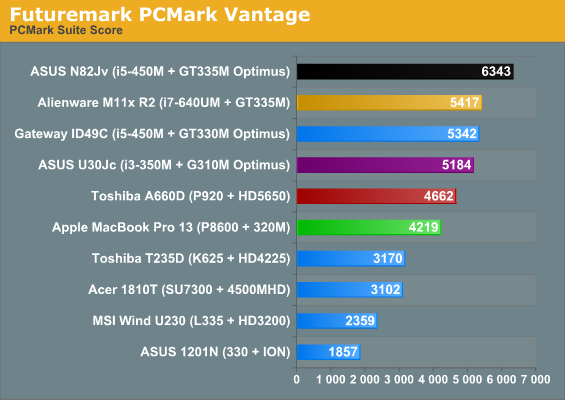
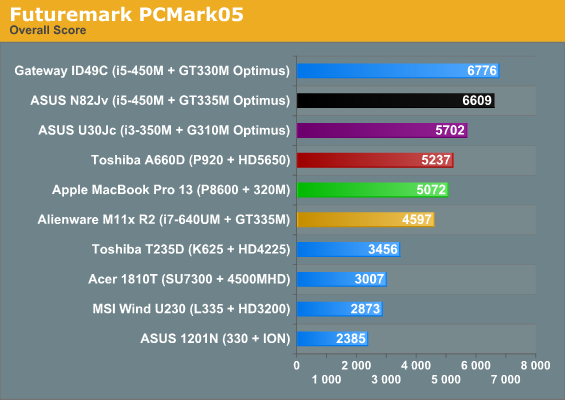
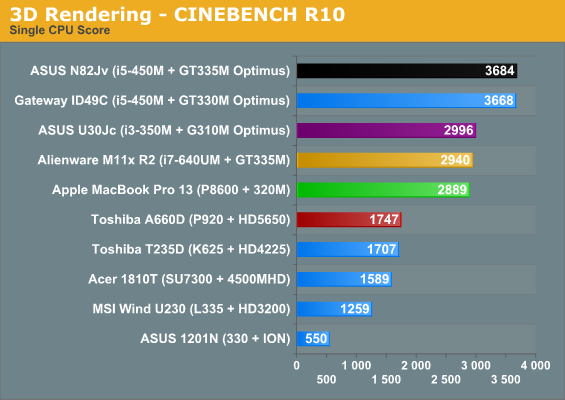
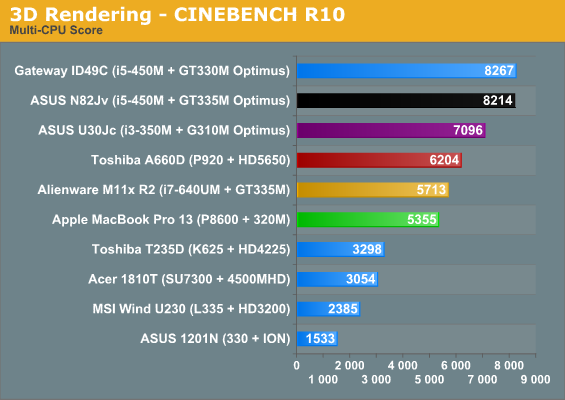
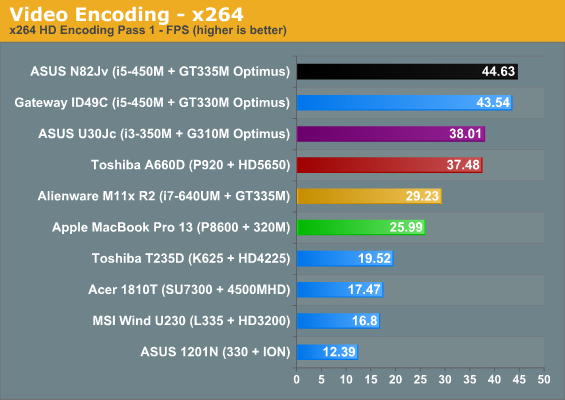
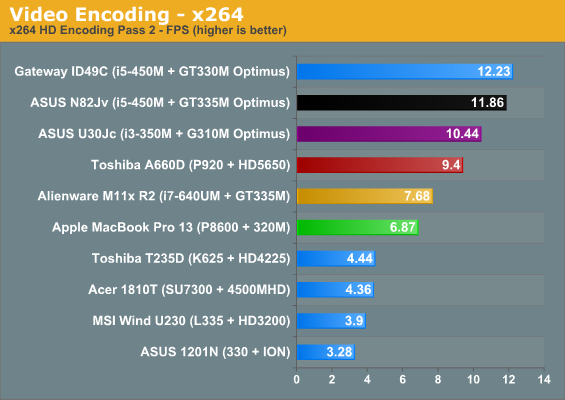
Here’s why it’s really sad: the MBP13 results would fit pretty well in our old Core 2 Duo notebook roundups, like this one from two years ago. The G50V and dv5t were $1200 notebooks back then, and they’re basically on par with the current MBP13. Quite frankly, it’s almost pathetic that Apple decided they could get away with a Core 2-based processor for another year at a price point that can get you a 14” aluminum unibody notebook with a quad core i7-720QM (HP, we’d still like to test an Envy 14, thanks). People expect Macs to cost more almost by default, but after a couple of years of the MBP13 being a decent value for a premium quality notebook (look at the old Envy 13 for comparison), it’s particularly jarring now to see it be so far behind the competition. I have none of these complaints for the Core i5/i7 sporting 15” and 17” models, however.
At this juncture, any notebook with a Core i3 can outrun the MBP. Same goes for the Core i7 ULV chip. We’ve never tested a Core i5 ULV, but we'll see the Core i3 ULV in a review shortly and it's in the same ballpark as Core 2—and the overclocked Core i3-330UM in the ASUS UL80Jt is basically on par with the MBP.
There are two ways you can look at this; you can say that at this point, anything with a Core 2 (even an old Merom) is more than powerful enough to run Windows and handle any reasonable task a thin and light notebook might be asked to. A lot of Apple fans say that. There’s another camp that says it’s completely unreasonable for Apple to sell a notebook with a Core 2 Duo processor at $1200, regardless of what it might be asked to do—there are smaller, thinner, lighter systems that perform better in basically every way. A lot of anti-Apple fans say that. They’re both right.
The Core 2 Duo is most certainly adequate to handle the normal, every day rigors of a portable notebook, but that’s not a reasonable justification for Apple selling a notebook that is more expensive than more powerful competitors. Apple is getting a bargain price on P8600 CPUs and the 320M chipset, which means the Core 2 + 320M is more about increasing profit margins than anything else. (And for those people who still cling to the theory that Apple couldn’t fit a third chip onto the board without reducing the battery size or making the notebook larger, that’s nonsense. If ASUS can manage to fit a Core 2010 processor, the chipset, and a dedicated graphics card into a system with similar dimensions to the MBP13 and a 33% larger battery, then Apple could have too. Simple as that.)
While we're here, we also ran all the 3DMark suites. This hints at the Core 2 + 320M combination being a lot more impressive than the above results, but then why couldn't Apple get GT 320M or faster with switching graphics into the system instead? Oh, right: that's only for 15" and 17" MBP. More on this when you hit the next page.
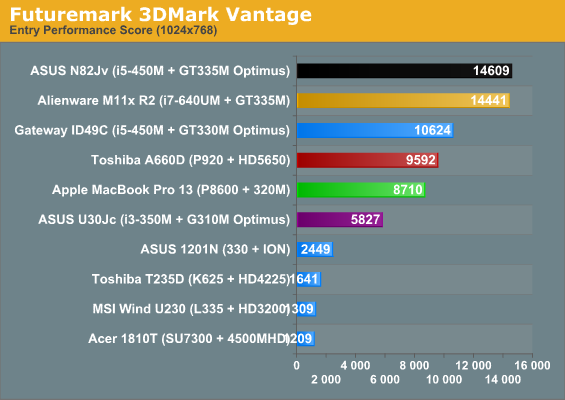
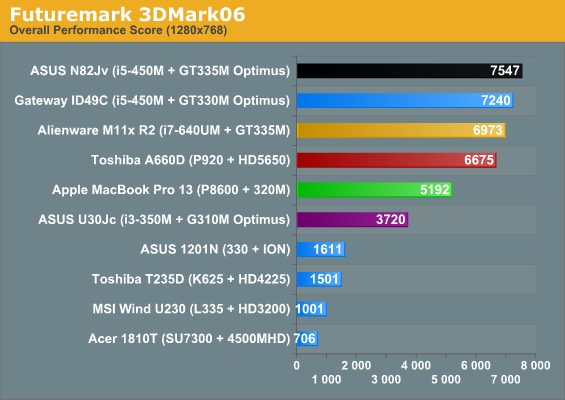
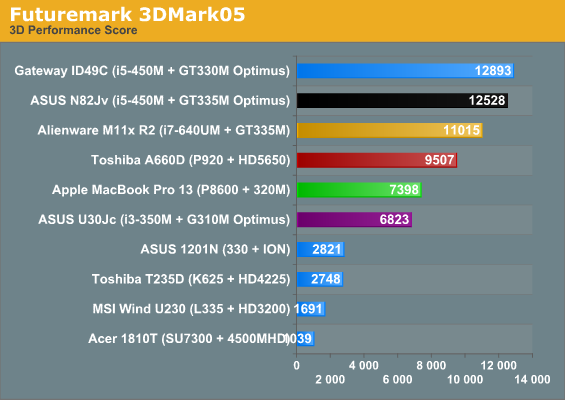
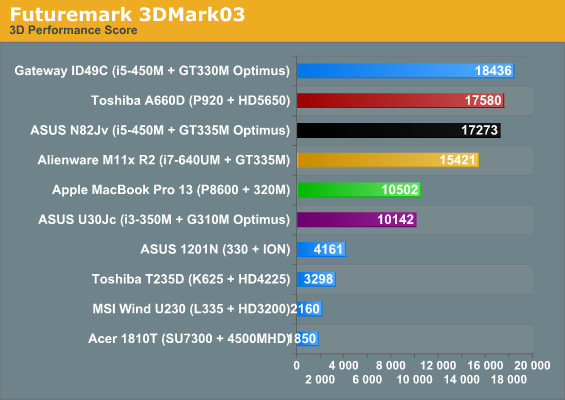
Okay, 320M looks decent, but the CPU is still old. We'll get into the graphics stuff on the next page, but while we're here looking at 3DMarks, we do have a quick question: how many of you want us to continue posting 3DMark results with our laptop reviews? We know they're a consistent point of reference for the long-term, but 03 and 05 in particular are getting very long in the tooth. So, if you want to sound off in the comments, would you like us to ditch 3DMark entirely, keep 06 and Vantage, keep all four like we've got above, or only skip 03/05?










117 Comments
View All Comments
disappointed1 - Friday, October 15, 2010 - link
I don't think your comparison holds. Movies can only ever be compared with reviews & scores on a star-based system, whether from newspaper critics or laypeople on IMDB, unless perhaps you are suggesting that you read the script beforehand to identify a weak script or watch clips to identify weak acting. If not, then the star system is still inherently subjective, whether you're looking at one reviewer or the aggregate reviews of millions.When I say 3DMarks are meaningless, arbitrary numbers, I mean that I can't go out and play 3DMark at 8,710 3DMarks. I can, however, play FC2 at a standardized resolution at 60fps, and as you imply, I'd even prefer that be just one factor in the review. There are tons of other games that include built-in, standardized benchmarks that report in meaningful frames-per-second, and more of these games should be substituted for the meaningless 3DMark numbers.
Sufo - Monday, October 18, 2010 - link
I think the comparison holds insofar as it makes my point that even subjective information - when presented as part of a larger body of information - can still hold value. Apart from that the two have next to nothing in common :)Personally I don't think it can hurt to have 2 extra (I say extra, they're already there) bars in a review - they're certainly not so ostentatious that they might preclude one's ability to ignore them, and at the same time there may be people that want em. If a review was *entirely* based around benchmarks then i'd understand the resulting frustration.
Incidentally, my gpu tends to do better in 3dmark than cards it's better than, and worse than cards it's not. This may be a lucky coincidence, but for me at least it provides a quick, albeit *somewhat* dubious reference point, as most new hardware will def get a 3dmark run, whereas it may not have been run against games i've benched.
beginner99 - Friday, October 15, 2010 - link
Are there any test around with battery live in linux? Is the better battery live a general linux/unix advantage or did apple tweak OSx on their own so much?Anyway makes you cry as a windows user...
(I recently installed Jolicloud on my eeepc. As far as I know it runs as a Virtual machine next to windows (dual boot). But it is still much faster and more responsive. pretty weird especially the responsiveness.)
JarredWalton - Friday, October 15, 2010 - link
I looked at this a while back with a couple laptops:http://www.anandtech.com/show/2840
At the time, Win7 bested WinXP bested Vista, with Ubuntu generally far behind. It may have improved since then, but drivers and power optimizations are critical to get the most out of your hardware in terms of battery life, and Apple has obviously spent some time in OS X on this stuff. Win7 is good, but the wide compatibility isn't helping it keep up with OS X.
kawatwo - Friday, October 15, 2010 - link
I bought a 13 inch MBP just to get some Mac experience and it is a beautiful screen. It makes a great coffee table laptop with the perfectly lighted keyboard as well. I am curious how much the faster 2.66 CPU would have helped on the benches, but that does lower the value equation a bit probably too. It handles every game I own so far at 1200x800 though not all at highest quality settings of course. Just as an aside after several months using OS X it still boots to the desktop in about 40 seconds with zero fine tuning with the stock HD which I find amazing.yyrkoon - Friday, October 15, 2010 - link
Not enough to spend the extra ~$40 USD. Or, in your case ~$259 USD to replace the CPU with a newer one. The P8600 is actually a very good CPU.As an example. I have an E6550( 2.33Ghz stock ) C2D overclocked to 2.8Ghz, and barely notice a difference. Mainly, I just did it because I could, and to run the "FSB" 1:1 with my memory. Even overclocked on up to around 3.8Ghz, there is barely a noticeable difference. Unless you start benchmarking games, and comparing FPS. But playing the games, either stock, or overclocked. The difference is barely, if even conceivable.
seanleeforever - Tuesday, October 19, 2010 - link
i really think your booting speed has more to do with what you install, than the h/w spec or the OS.my netbook with 1.6G atom processor still boot up in 40 seconds after 2 years of use. so?
plewis00 - Friday, October 15, 2010 - link
Is the battery life thing anything to do with BIOS in regular PCs vs. EFI in Mac machines? In a previous article it had been mentioned that Windows 7 'could' run on Moorestown (Intel's new Atom) but due to the constant bus-polling, etc. that is built into Windows it could never achieve low-wattage idles and the bus-polling is part of the antiquated BIOS architecture PCs use - this is just a theory, but also having read UEFI-based PCs could boot in seconds, I imagine Mac OS X's speed and efficiency is down to having semi-custom hardware with many unnecessary and legacy processes not running. I could be wrong and if I am and someone knows please explain where.fokka - Friday, October 15, 2010 - link
i must say when i saw the article i was really looking forward to reading it, because it's exactly what i am doing right now - trying out win7 on the latest 13" mbp.but in the end it seemed a little too positive, at least to me.
while i agree, that the the 13 incher is a great little machine, especially on windows its not without it flaws.
the first thing that comes to my mind is the long booting time. i think it has to do with the bios-emulation, but that really shouldn't last that long.
second there is the choppy and much too fast scrolling, which i yet have to find out how to slow it down.
the third point is not a windows-one, but never the less i have to mention it: the display is not that good. sure, on paper and even in real life it looks fine with high contrast, brighness and color gamut, but it still is a tn-panel and so the viewing-angles are only "good enough".
there are other shortcomings as a win-notebook, too, like the keyboard-layout and, of course, battery life.
so all in all it's a great machine, but it sure as hell isn't designed for windows.
mrsmegz - Friday, October 15, 2010 - link
I had a Macbook 13 aluminum w/ the 9400 for a year. I really liked the notebook for all the reasons mentioned above, the touchpad, the screen keyboard etc. However I had more than a few hangups running Windows 7 on the laptop. 1), Bootcamp wouldn't support 64 bit windows 2) Sound would only come out of one speaker/headphone at about 20pct volume while the other was at 100pct 3) it got so damn hot sitting in your lap, the aluminum just didn't vent the laptop enough. Everything else on Windows though, worked much as the article explained, If they fix those problems, I will consider getting another next cycle.